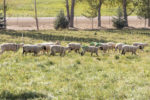Forage Production
By delaying grazing slightly in early spring so the grass grows taller and increases its DM percentage by a modest 20%, we boost the amount of energy available for lactation by 34%.
Read More
Embracing failing wheat acres
With winter approaching, it may be hard to watch the weather destroy your winter wheat crop. Being prepared and having a backup plan may save your sanity.
Read More
Will your fertilizer spreader be ready for go time?
Comprehensive checklist for end-of-season dry applicator equipment inspections.
Read More
How did the 2023 alfalfa seedings survive the summer?
There are economic benefits to turning over low-yielding stands and taking legume credits and rotational benefits rather than keeping the low-yielding field.
Read More
Don’t leave money in the field
At the end of the day, high-quality forage means a healthy herd and a better bottom line.
Read More
Pivot irrigation rolls forward with new technology
The new technology can save wear and tear on your pivots and optimize the crop and is completely customized.
Read More
Spotted lanternflies hitchhiking across the country
The secondary effects of spotted lanternflies impact forage producers' secondary sources of income as well as farm equipment and infrastructure.
Read More
Is your alfalfa ready for winter?
Management considerations will optimize winter survival and yield of first cutting next year.
Read More
High-ammonia forages: Effect on cattle
Taking precautions at harvest, controlling the amount of ammonia in a diet and monitoring cattle to determine if they are being fed too much ammonia can help to manage the forage you have.
Read More
The power of alfalfa: Enhancing dairy nutrition and flexibility
By leveraging alfalfa’s nutritional advantages, resilience and trait benefits, dairy farmers can pave the way for healthier, more productive herds while contributing to the long-term health of their soil.
Read More









